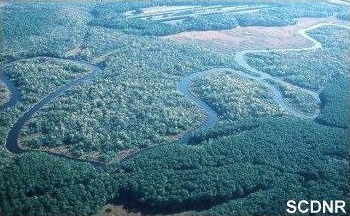Characterization of the Ashepoo-Combahee-Edisto (ACE) Basin, South Carolina
Biogeochemistry

Biogeochemistry refers to the underlying chemical processes that dictate the cycling of major elements (i.e., carbon, hydrogen, nitrogen, oxygen, phosphorous, sulfur) in an ecosystem. In general, very little biogeochemical research has been performed in the ACE Basin; however, other estuarine systems in South Carolina have been studied and inferences can be made about how these systems may vary after accounting for the unique attributes of the ACE Basin. Some of the unique characteristics of estuaries in the ACE Basin include the black water of the Edisto River, landscape characteristics such as the lack of urbanization in the basin, and its extensive network of wetlands.
The Edisto is one of the longest free-flowing black water rivers in the United States, and is laden with dissolved organic matter, the bulk of which (humic acids) is resistant to metabolic breakdown by bacteria. The high concentration of humic substances in the black water act to bind phosphorus until it comes into contact with saltwater, when a precipitation/flocculation event occurs releasing orthophosphate into the estuary system. In the higher salinity regions of the estuary where phosphorus has desorbed and becomes bioavailable, primary production is limited by nitrogen. Nitrogen loading in the high salinity estuary will be more important to carbon biogeochemistry than in the low salinity estuary. Nutrients in marsh pore water along the Edisto River tend to be higher than the concentrations observed in the Cooper River and Winyah Bay/ North Inlet. The nutrients carried in the black water discharge that dominates the ACE Basin study area may impart estuarine-wide eutrophication in a relatively pristine and nutrient-sensitive estuary.
Overall, the ACE Basin appears to be a healthy ecosystem because of low levels of nitrate/nitrogen in its estuaries and the balanced nitrogen to phosphorus ratio. However, relatively high ammonium and phosphorus concentrations do exist in the water column. This information suggests future management of the ACE Basin ecosystem should be directed at maintaining balanced nutrient ratios.
